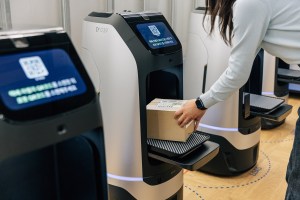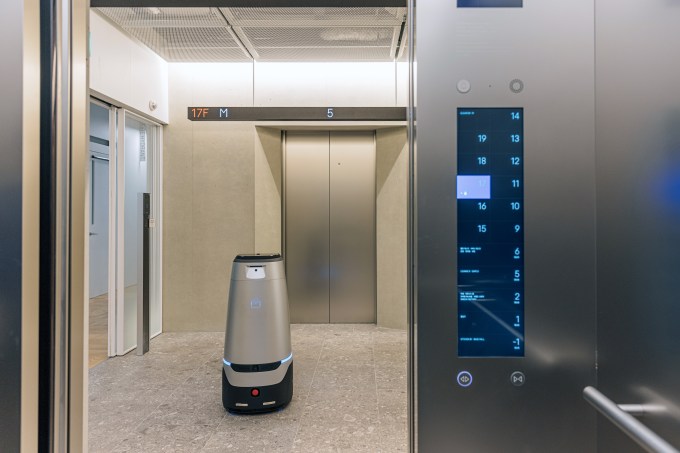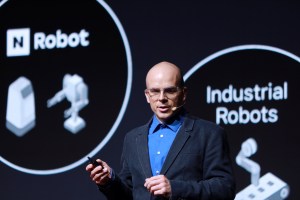In July last year, Naver, maker of the search engine known as the “Google of South Korea,” opened its new second headquarters, Naver 1784. The building’s name refers to a year commonly associated with the Industrial Revolution. Inside you’ll find a testament to automation’s growing global influence, in the form of 100 autonomous robots.
The robots, called Rookies, weave in and out between people and deliver parcels, coffee and lunch to Naver’s employees, all using 5G. They even have their own robots-only elevator, Roboport. Naver Labs, the company’s R&D division, launched using the new headquarters as a test bed for the Rookies. This November, it will arrange the robots in its new data center, Gak Sejong, in South Korea.

I visited the site last year, to see the robots firsthand. Rookies navigate through every inch of the headquarters, while robot arms drew pictures. Naver already owns a raft of subsidiaries, offering services like e-commerce, messaging, payments, digital comics, cloud and metaverse. And, just last week, the company launched its generative AI services built on its large language model HyperClova X, joining the generative AI space race.
Does the internet giant want to broaden robotics, artificial intelligence, and autonomous driving technology beyond its existing businesses to drive its future growth? When asked about its ongoing projects, Naver says it has been working on a handful of projects on robots, autonomous driving technology and AI, via its R&D division since 2013. Six years ago, it acquired Xerox Research Centre Europe (XRCE) in Grenoble, France, which specializes in researching AI, machine learning, computer vision and natural language processing, to bolster its research and development. Post-acquisition, XRCE became Naver Labs.
The company believes people living in such innovative environments will benefit from the Naver Labs projects — including robots — in the not-too-distant future. The internet search engine wants to take part in the new kind of platform, robots, which it believes could replace mobile phones one day.
Naver Labs‘ research is aimed at five spaces: robotics (Around, Around G and Ambidex), AI (ARC System), digital twins (Alike and Hybrid HD mapping), computer vision/augmented reality (Indoor AR Navigation and Ahead) and autonomous driving technology.
At Naver’s AI conference last week, TechCrunch sat down with the director of Science at Naver Labs Europe (NLE), Martin Humenberger, to learn about Naver Labs’ mission and ongoing projects.
“Our long-term vision is creating useful robots in everyday lives,” Humenberger tells TechCrunch. “This includes robot assistants at home, hospitals, museums, shopping malls, airports, etc. More short-term, we focus on last-mile delivery applications in smart cities and buildings.”
Most of its long-term projects haven’t been commercialized yet. Still, its ongoing research and latest technology are continuously applied to improve the performance of Naver’s robots, Rookies, at the 1784 building and the data center, Gak. In addition, it provides a robot as a service (RaaS) to the Naver Cloud platform, Humenberger adds.
One example of RaaS is the ARC system powered by the Naver Cloud Platform. ARC, an intelligence system for robots, enables Naver’s Rookies to see, recognize and operate. ARC isn’t just a control system for robots. It is the robots’ eye and brain, which means Rookies don’t require GPS access; instead, the ARC eye helps them recognize their surroundings, while providing the most efficient route. That’s according to Vision Group leader at Naver Labs Korea, Donghwan Lee, who leads the ARC eye project. ARC Brain, meanwhile, connects service infrastructure in real time and updates data and algorithms in the cloud for robots. Rookies at the 1784 building don’t need a built-in operating system thanks to their cloud connectivity that powers the ARC system, which controls the robots, Lee added. Naver says the ARC system can reduce the robot’s manufacturing cost and battery consumption by moving tasks robots have to treat to the cloud.

Both Naver Labs in South Korea and France have some clear mutual goals, but others run in parallel, says Humenberger. The collaboration is based on information and progress sharing until they define joint objectives.
While Naver Labs Europe (NLE) focuses its research on “the fundamentals of AI and how to overcome current and future challenges in AI,” Naver Labs Korea (NLK) researches and develops robotics, systems engineering and platform engineering and operations, he adds.
The primary research area of NLE is the AI technology for robotics. NLE is developing “computer vision methods for next-generation robot perception,” which helps robots understand the environment better, and “new methods for sequential decision making and combinational optimization, which enables the robots to navigate in unknown environments or to perform complex manipulation tasks,” Humenberger explains. NLE is also building a technology that allows efficient interaction between robots and humans via language.

To make Naver’s robots versatile assistants, NLE advances AI-powered computer vision, machine learning for robotics and natural language processes.
“It is true that we count a lot on AI-powered computer vision to better understand the world (semantics and geometry), reinforcement learning to teach robots to execute tasks, and natural language processing and information retrieval to make knowledge (text, images, videos, etc.) accessible to our robots,” Humenberger tells TechCrunch.
He gives an example of a concrete research activity related to foundation models for the real world, CroCo. CroCo is a foundation model for 3D in one image. “It is designed to understand the world in 3D using images,” Humenberger said, adding that it’s not for generative AI or large language models but for robotics and digital twins. “At Naver Labs, we use CroCo as an advanced robot perception module for tasks such as localization, navigation, and interaction between human and robot.”
“We have a massive test bed where we can develop and operate robots in the real world, highly skilled engineers and researchers, and powerful cloud infrastructure,” Humenberger explains. “It is quite difficult to secure even one of these conditions, and it is safe to say Naver is the sole company that is equipped with all of them.”
NLE has more than 100 researchers and scientists in the fields of AI, ranging from core machine learning to UX, according to Humenberger. Naver Labs did not disclose the number of staff in Korea due to confidentiality issues.
South Korean tech behemoths, such as Samsung, LG, Hyundai and Doosan, are working in the pipeline of robotics development, from industrial robots to cooking, serving, and delivery robots, and ploughing capital into the robotics space. Earlier this year, Samsung said it plans to roll out an EX1 robot to assist elders in exercising, and its research division is developing a Samsung robot platform. Doosan Robotics, a robotics unit of the Korean manufacturing firm Doosan, has filed for an initial public offering, according to its filing.
Rice Robotics picks up $7M, powers SoftBank’s office delivery
Want the top robotics news in your inbox each week? Sign up for Actuator here.































Comment